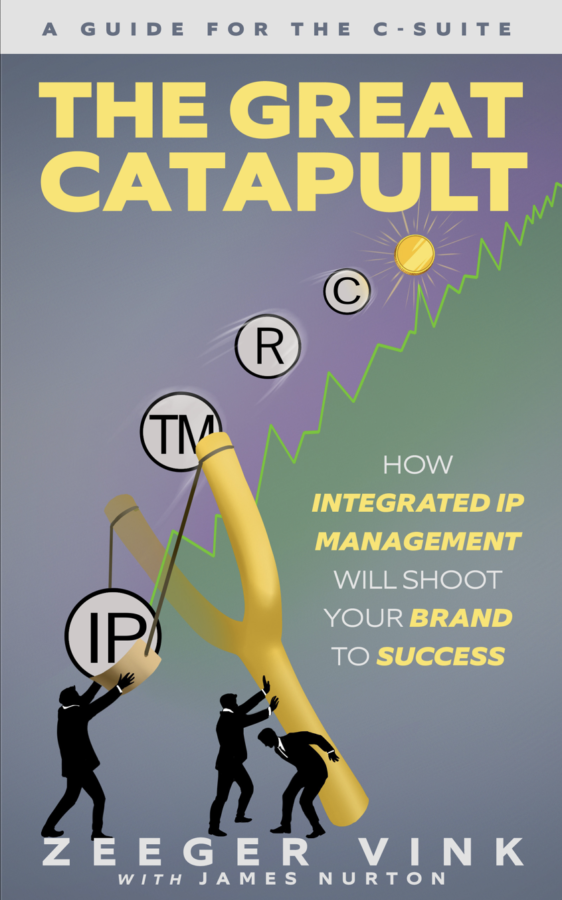The C-suite can embrace the intangible economy through “Integrated IP Management”

Intellectual property: An economic asset
In a globalized world where competitive advantages are almost instantly competed away, only Intellectual Property rights (IP) can provide durable protection of a company’s economic position. Exclusive IP rights on brands, technology, design, and data have become of strategic importance to companies, both as revenue generator and as asset – often exceeding the value of physical assets. To support this global move into the intangible economy, senior management not only needs to understand the general functions of IP but also assure that the right organizational structure is in place to take full advantage of this global reality.
At brand-driven companies, IP historically has a well-established relationship with Marketing. IP’s function in marketing is crucial because it allows to safeguard the often-huge investments in the promotion of its brand and products. Brands and other elements of a company’s visual identity can be protected through trademarks, copyrights, design rights, which guarantee exclusive use in the marketplace. Similarly, in technology companies IP tends to be closely related to R&D departments in order to secure inventions through patents.
In its slipstream, IP may also have a strong link with Finance. As IP rights can be licensed to third parties to monetize the value embedded in it, the generated license revenue (generally referred to as royalties) can represent a significant part of the company’s revenue. Finance departments in such companies tend to have a solid understanding of the function and structure of IP in order to manage and preserve its value.
But apart from the marketing and finance functions, IP should permeate through the entire organization and reach multiple other divisions in order to truly optimize IP’s power as a revenue generator and value captivator. The goal of good IP management is therefore to actively weave IP into the fabric of the company as a whole. It means that IP is not considered as a purely legal, stand-alone function anymore, but is integrated into virtually every aspect of the company. This approach, which can be referred to as Integrated IP Management, is crucial for the competitiveness and longevity of companies focused on creativity and innovation.
IP strategy
The starting point for companies to assure that IP can play its enabling and preserving role to the maximum extent, is to adopt an IP strategy. That can be in the form of a stand-alone IP strategy, or even better: as part of the general company strategy. Such formalization of IP’s place in the company allows all stakeholders to appreciate its importance, help formulate goals, and make people accountable for them. It also provides the IP staff with the necessary authority to coach and intervene on behalf of senior management at the various levels and functions of the company where IP contributions can be optimized.
Integrated IP management
How can executives make sure that every function of their company contributes to the optimization of its IP? Let’s use some concrete examples relating to various divisions:
- Design and Product Development teams should be obliged to systematically submit new creations to the IP department to assess options for filing IP rights; true champions even orient the development process towards products that offer the strongest protection, as these provide the best defense against price erosion.
- Human Resources makes sure that employment contracts contain clauses that enable the company to remain or become the owner of any IP developed by its employees.
- Sourcing, Purchase and Procurement managers assure that the company can freely use any third-party IP attached to products or components sourced from outside, or better: insist on the transfer of that IP to the company.
- Business Development uses publicly available IP data (i.e. trademark and patent databases) to keep track of competitors and the market.
- Communication sees to it that all ads, publicity, and other public materials are in strict conformity with the company’s IP rights and avoids any use that could dilute or otherwise harm their strength.
- Consumer Insight teams include negative aspects of brand perception, such as the presence of counterfeits, into their research and actively follows the extent to which this affects the brand.
- Distribution and Retail are charged with market surveillance and report any violation of rights by competitors to the IP department for further action.
- ECommerce makes sure that the online platforms through which the company sells its products are respectful of IP and negotiates stringent IP commitments upfront in order to block imitations, counterfeit products and unauthorized brand use.
More generally, all functions need to be mobilized to protect the company’s IP and help strengthen it. Only then can IP reach all layers of the company and become truly integrated into the company structure. Integrated IP Management forms an essential precondition for any company wanting to be ready for the intangible economy and the next generation of global commerce.
Building IP-consciousness
The implementation of Integrated IP Management requires an organization to have sufficient IP-consciousness: the awareness among employees of the importance of IP and their general dedication to letting it flourish. It is a reality that “silo-ed” corporate departments are often reluctant to open up their workings, which forms an obstacle for aligning their operations with the company’s IP strategy. Managers and employees should come to realize that regular involvement of IP staff is not a complexifying nuisance but a business enabler for their projects – as well as for the company’s long-term commercial prospects. IP-conscious managers actively seek the input of the IP team in order to discuss how they can contribute to the optimization of existing IP, and relentlessly try to create value by extracting new IP from new creations and innovations.
IP-consciousness cannot be imposed upon an organization through a single decision of top management. It requires steady and repeated action over time, such as company-wide IP trainings, regular IP reporting to all stakeholders, and intensive interaction between IP staff and operational divisions. While this does need the initial (and continued) sponsorship from management, its execution will depend on the IP department and the extent of its mandate. Together, Management and the IP department could therefore develop an IP-consciousness roadmap, laying out the steps, timeline, and budget to reach the common goal. IP-oriented companies formalize the creation and sustaining of IP-consciousness as a strategic objective and actively monitor its progress.
Ultimately, all employees need to have IP-consciousness to contribute to IP as strategic asset. They need to understand the relevance of IP to the organization and be convinced of its contribution to the company’s well-being. In this respect it is interesting to note that economic impact studies in the EU and the US demonstrate that IP-intensive industries pay a wage premium of almost 50% compared to non-IP intensive companies. That forms an additional incentive to pursue a strong IP culture, in the collective and individual interest.
A best practice is to highlight the importance of IP in the company’s main strategic documents. That can be its value set, its mission statement, or otherwise. For example, some companies include IP commitments in their Code of Conduct, a document laying out the basic ethical, behavioral, and organizational principles for their employees. Concrete IP commitments can include:
- Submitting all projects, including branding, product development, design, advertising, and corporate communications, to the IP department before public divulgation;
- Reporting product imitations and unauthorized use of the brand.
A key ingredient of IP-consciousness is confidentiality. Employees, in their enthusiasm for new creations and getting them to the market quickly, sometimes disclose elements publicly before they have been seen by the IP department. Creations may involve elements that could potentially be protected by IP rights but require prior filing at a register to be valid. Divulging the elements before filing may make them ineligible for protection. Or worse, competitors could use the disclosed elements to use or file them first, providing them with priority rights that could even obstruct the use by your company itself. In other words, employees should be conscious that anything they create contains potential competitive advantages that require protection before divulgation, for the risk of letting valuable know-how slip away to competitors and the public domain.
Another good practice to create IP awareness among employees is providing dedicated IP training. That can consist of made-to-measure courses for selected teams, such as Design, Innovation and other teams involved in product development, in order to create the appropriate IP reflexes and provide operational guidelines on product clearance. But training can also focus on a wider audience and include minimum IP notions in induction programs for all new employees. Today, eLearning tools are an efficient way to reach large numbers of employees, across continents.
Involving the supply web
IP-consciousness and corresponding commitments should not be limited to employees: the company’s suppliers also play a crucial role. When the aim is to secure and protect all IP that makes your company’s clockwork tick, Integrated IP Management involves its entire economic fabric and operational infrastructure. Companies do not operate in an isolated way but use a wide diversity of suppliers for all functions and divisions; it is the reason why the term supply web has become common. In IP-conscious companies, this entire web is geared towards the optimization of IP.
In Sourcing, external partners such as manufacturers and suppliers of components and accessories need to provide assurances that their products do not infringe third parties’ IP rights, to avoid production disturbances in case of claims. Sourcing partners can also report infringing activities of competitors, for example those that serve the counterfeit industry.
In Marketing, contributions by outside vendors such as copywriters, photographers and designers are all covered by IP rights, including copyrights and design rights. As these elements fold into the final brand image, it is important to make sure they can be used without limitations. Ideally, the ownership of the related IP is transferred to the company to enable full and durable commercial exploitation (think of corporate logos). In larger companies, the high number of projects may require standardized and mandatory IP clauses in all supplier contracts.
In Product Design, companies also often work with outside vendors to contribute to the design process. Similarly, these vendors need to be actively managed to make sure the company obtains unrestricted access to the IP rights attached to the design. Contrary to popular belief, design rights and copyrights do not automatically belong to the company that orders the design, but require a formal assignment to secure unlimited use.
In Digital, platforms used for promotion and advertising (such as social media) have the capacity to block accounts that make unauthorized use of the company’s copyrighted content such as photos, music, and videos. Similar to eCommerce platforms, today many brands actively monitor social media and request the removal of illegal content (through a process called Notice-And-Take-Down), but they can go further and insist on proactive brand protection commitments in commercial negotiations with platforms.
In summary, Integrated IP Management assures that all suppliers are geared towards the optimization of the company’s IP. While Marketing, Sourcing or eCommerce teams may initially be hesitant to impose what they were previously inclined to see as mere legal details that could disturb commercial interests, it is often surprising how forthcoming suppliers can be on the IP front, as they also understand that active IP protection can improve the chances for a successful and lasting commercial relationship.
IP reporting and valuation
Practicing Integrated IP Management implies an updated vision on the role of the IP department. It is evolving from a purely legal to a more counseling one, guaranteeing that IP can fulfill its function as value generator throughout the company. This requires additional skills, for example in the field of communication (think of IP trainings) and finance, which HR departments need to consider when recruiting for IP positions.
One such extended activity that the C-suite of IP-intensive companies insists on is IP reporting. The IP department needs to provide the Board and senior management with a clear picture of where the company stands in terms of IP performance. This not only includes an overview of IP rights, but also the state of IP consciousness, the extent and result of brand protection activities, and an estimation of the financial contribution of these activities.
Financial reporting is where Integrated IP Management culminates. The company accounts should give a comprehensive overview of the revenues generated with IP, for example through the licensing activities mentioned earlier. The costs and revenues of IP form the basis for its valuation, with the aim of listing it as intangible asset on the corporate balance sheet. This way all stakeholders have insight in the value creating process. Moreover, it optimizes funding opportunities, as the IP assets will serve as key collateral in financial transactions – a necessity in the increasingly intangible economy.
About the author:
 Zeeger Vink is Intellectual Property Director at MF BRANDS, the Swiss group that owns the fashion & lifestyle brands LACOSTE, GANT, AIGLE, TECNIFIBRE and THE KOOPLES. In this role he oversees the group’s global IP function and leads a team of specialized IP professionals responsible for all prosecution, clearance and enforcement work.
Zeeger Vink is Intellectual Property Director at MF BRANDS, the Swiss group that owns the fashion & lifestyle brands LACOSTE, GANT, AIGLE, TECNIFIBRE and THE KOOPLES. In this role he oversees the group’s global IP function and leads a team of specialized IP professionals responsible for all prosecution, clearance and enforcement work.
Prior to joining LACOSTE, Zeeger was in-house IP counsel at L’OREAL in Paris (France), where he was in charge of global IP protection for several group brands. He started his career as attorney, practicing in the Netherlands and the United Kingdom.
Zeeger holds a master’s degree in law from the University of Amsterdam, with specializations in IP law and Marketing. He taught IP at the international master’s program of SCIENCES PO University in Paris, and speaks and writes regularly on topics of corporate IP management. Zeeger currently serves as President-Elect of the International Trademark Association (INTA). He actively advocates the creation and protection of IP, inter alia through his book THE GREAT CATAPULT: How Integrated IP Management Will Shoot Your Brand to Success (2020).



